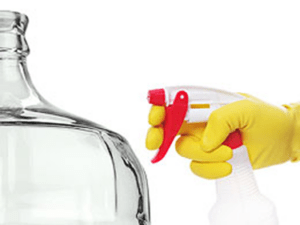 Hello Winemakers:
Hello Winemakers:
I am getting ready to start my first batch of wine from concentrate. I am a little confused about the sanitizing process for large pieces of equipment. The directions say to dissolve so much sanitizing stuff to one gallon of water. Does this mean a gallon will do the job? With a 6 gallon tuft tank or a 6 gallon glass carboy, for example, do you pour the gallon in the container and slosh it around? If so for how long? Directions say to soak corks from 5 to 10 minutes. Small items such as hydrometers can be submerged, but I am a little vague on doing the big items and some of the other details?
Thanks,
Mike H.
—–
Hello Mike,
The methods you are referring to are appropriate when using sulfites (sulfur dioxide) to do your sanitizing.
Sulfite is the most common ingredient home winemakers use to sanitize their equipment and supplies. Sulfites can be purchased as either Sodium Metabisulfite or Potassium Metabisulfite — both are granulated powders — or as Campden Tablets. Any of the three can be mixed with water to create a solution with the same active ingredient, SO2 (sulfur dioxide). Some of the sulfur dioxide will bond to the water itself. Some will start to release slowly as a gas. This gas is known as the ‘free’ SO2. This free gas is what actually does the sanitizing.
In the case of sanitizing your fermenters, you only need to put in a few inches worth of the solution to sanitize them. Just seal the fermenter up with a lid and/or airlock, and let it sit for a few minutes. The fumes from the sulfite solution will do all the work. You do not need to slosh, soak, scrub, or do any of that kind of stuff. Just follow the directions that are listed on the side of each of the containers we offer.
If you are sanitizing a container with a larger opening such as a bucket-type plastic fermenter, you can also put all your smaller winemaking equipment inside, and sanitize everything at the same time. Hydrometers, hoses, rubber stoppers, airlocks can be put in the plastic fermenter and easily taken care of in a single step.
It is important to realize that a sulfite solution made with any of these three ingredients: Sodium Metabisulfite, Potassium Metabisulfite or Campden Tablets, are the only solutions that do not need actual surface contact time to do their sanitizing. All the other sanitizers we offer ‘do’ require some contact.
These contact sanitizers work well for the smaller items that can be easily soaked, and for larger items that can be easily wiped down, such as grape crushers and grape presses. But when it comes to sanitizing fermenters, wine bottles, glass jugs and other containers, it’s hard to beat using a sulfite solution.
Happy Wine Making,
Customer Service
———————————————————————————————————
Ed Kraus is a 3rd generation home brewer/winemaker and has been an owner of E. C. Kraus since 1999. He has been helping individuals make better wine and beer for over 25 years.

Thanks for the information on not sloshing the sanitizers. I was a slosher….it will save me time and effort . Now its pour in the mixture and go drink a glass of wine..:)
Hi
I have been tryuing to find a step by step instruction on making grappa from my pressed skins. On line they describe it but not insufficient detail. For instance does it have a head and a tail as in making moonshine?
Paul, anytime you distill you want a head and a tail. That’s just standard distilling. What’s more important is how you go about fermenting the skins in preparation for Grappa. We do not have a specific recipe. But we do have some general information about this at our other blog: http://www.winemakingblog.com Look for the article, "Making Second-Run Wine" dated September 15, 2008.
For sanitizing bottles, I use potassium metabisulfite and a bottle brush. Is this the right way to sanitize?